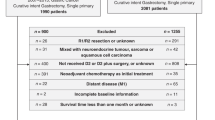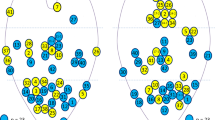Abstract
We analysed data on 1117 patients with gastric cancer who were treated by curative resection. Attention was focused on invasion and a recurrence of the cancer. Based on a univariate analysis, death following a recurrence and prognosis were related to age of the patients, size of the tumour, tumour location, tumour tissue differentiation, growth pattern, depth of invasion, lymphatic and vascular invasion and lymph node metastasis. In proportion to the growth potential, determined by the level of proliferating cell nuclear antigen (PCNA) labelling, the death related to a recurrence was increased and the prognosis was poorer. Multivariate analysis showed that the three factors of serosal invasion, PCNA labelling index and lymph node dissection were independent prognostic factors. When sites of recurrence were analysed regarding each depth of invasion, haematogenous recurrence, in particular in the liver, occurred even in cases of an early invasion and many types of recurrences, including peritoneal recurrence, were noted in patients with an advanced state of invasion.
This is a preview of subscription content, access via your institution
Access options
Subscribe to this journal
Receive 24 print issues and online access
$259.00 per year
only $10.79 per issue
Buy this article
- Purchase on Springer Link
- Instant access to full article PDF
Prices may be subject to local taxes which are calculated during checkout
Similar content being viewed by others
Author information
Authors and Affiliations
Rights and permissions
About this article
Cite this article
Maehara, Y., Emi, Y., Baba, H. et al. Recurrences and related characteristics of gastric cancer. Br J Cancer 74, 975–979 (1996). https://doi.org/10.1038/bjc.1996.468
Issue Date:
DOI: https://doi.org/10.1038/bjc.1996.468
This article is cited by
-
A prognostic scoring system for conversion surgery after trastuzumab-based chemotherapy for human epidermal growth factor receptor 2-positive advanced gastric cancer
Surgery Today (2022)
-
The prognostic impact of macroscopic serosal change on resectable advanced gastric cancer
BMC Cancer (2021)
-
Clinicopathologic and immunohistochemical characteristics of gastric adenocarcinoma with enteroblastic differentiation: a study of 29 cases
Gastric Cancer (2016)
-
A case of large cell neuroendocrine carcinoma of the esophagogastric junction
Esophagus (2015)
-
Metachronous Liver Metastasis from Early Gastric Cancer
Journal of Gastrointestinal Surgery (2012)



